Myanmar Market Entry: A Case Study of Bee Cheng Hiang's Expansion
VerifiedAdded on 2023/06/12
|28
|9101
|59
Case Study
AI Summary
This case study delves into Bee Cheng Hiang's potential expansion into Myanmar, evaluating the market's suitability for the Singaporean food chain. It employs SWOT, PEST, and Porter's Five Forces analyses to examine the business environment and market dynamics. The analysis covers Myanmar's market characteristics, competitive landscape, cultural environment, and potential entry strategies for Bee Cheng Hiang, focusing on the viability of introducing its signature 'bakkwa' product. The study further explores the 4P's marketing mix, providing a comprehensive assessment of the opportunities and challenges Bee Cheng Hiang might encounter in Myanmar, and offers insights into how the company can leverage its strengths to succeed in this new market. Ultimately, the case study aims to determine whether Myanmar is a promising market for Bee Cheng Hiang's expansion plans.
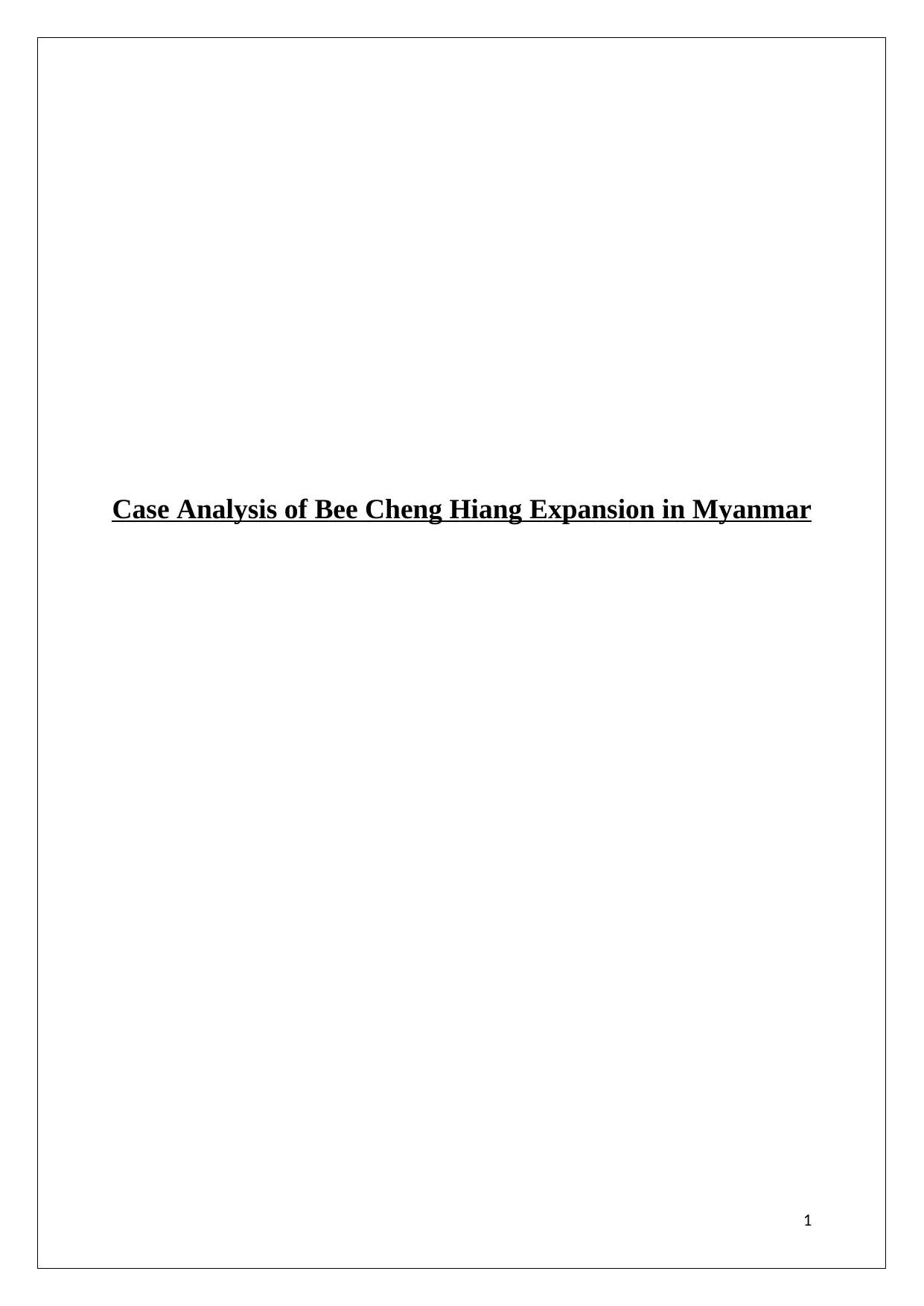
Case Analysis of Bee Cheng Hiang Expansion in Myanmar
1
1
Paraphrase This Document
Need a fresh take? Get an instant paraphrase of this document with our AI Paraphraser
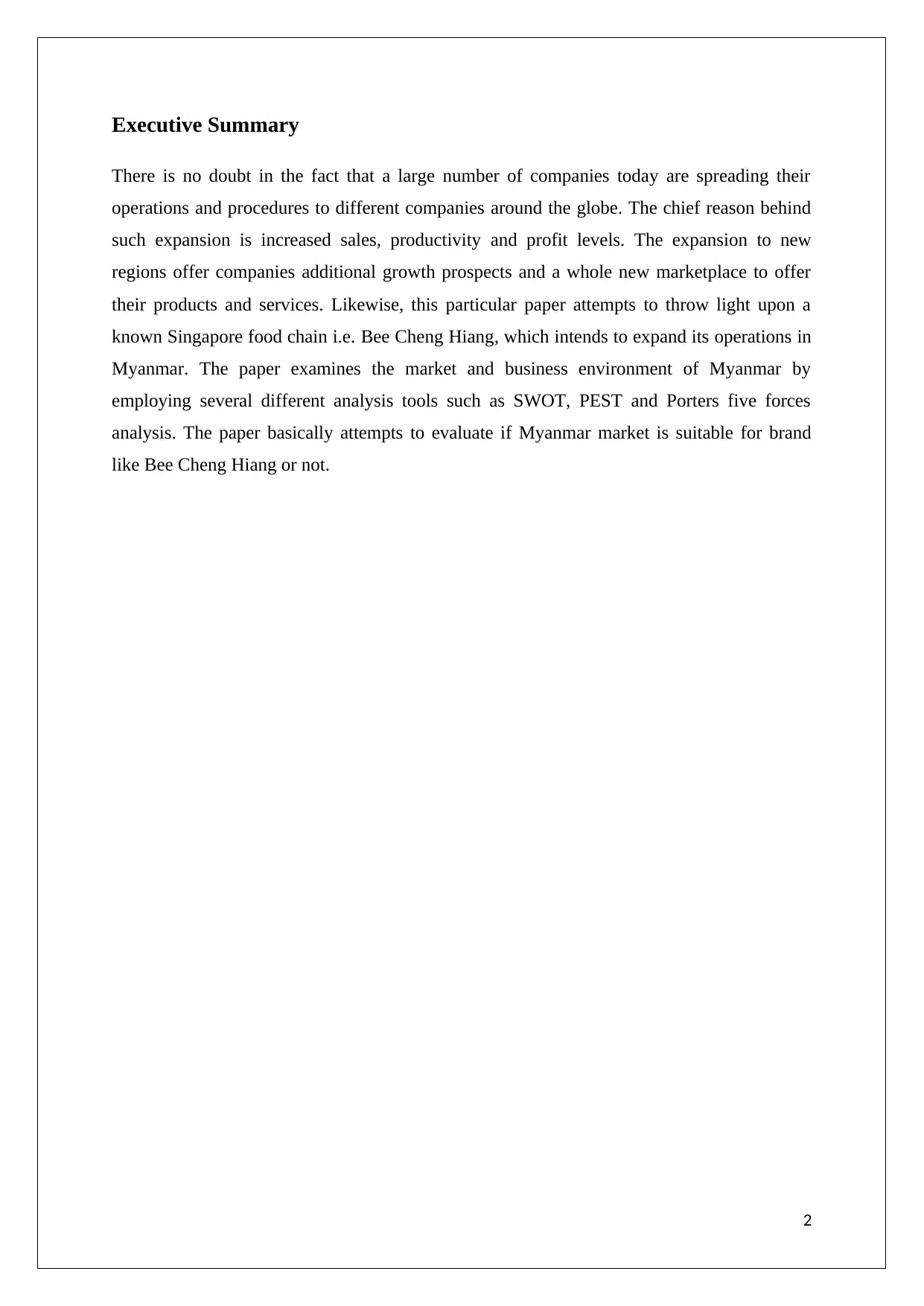
Executive Summary
There is no doubt in the fact that a large number of companies today are spreading their
operations and procedures to different companies around the globe. The chief reason behind
such expansion is increased sales, productivity and profit levels. The expansion to new
regions offer companies additional growth prospects and a whole new marketplace to offer
their products and services. Likewise, this particular paper attempts to throw light upon a
known Singapore food chain i.e. Bee Cheng Hiang, which intends to expand its operations in
Myanmar. The paper examines the market and business environment of Myanmar by
employing several different analysis tools such as SWOT, PEST and Porters five forces
analysis. The paper basically attempts to evaluate if Myanmar market is suitable for brand
like Bee Cheng Hiang or not.
2
There is no doubt in the fact that a large number of companies today are spreading their
operations and procedures to different companies around the globe. The chief reason behind
such expansion is increased sales, productivity and profit levels. The expansion to new
regions offer companies additional growth prospects and a whole new marketplace to offer
their products and services. Likewise, this particular paper attempts to throw light upon a
known Singapore food chain i.e. Bee Cheng Hiang, which intends to expand its operations in
Myanmar. The paper examines the market and business environment of Myanmar by
employing several different analysis tools such as SWOT, PEST and Porters five forces
analysis. The paper basically attempts to evaluate if Myanmar market is suitable for brand
like Bee Cheng Hiang or not.
2
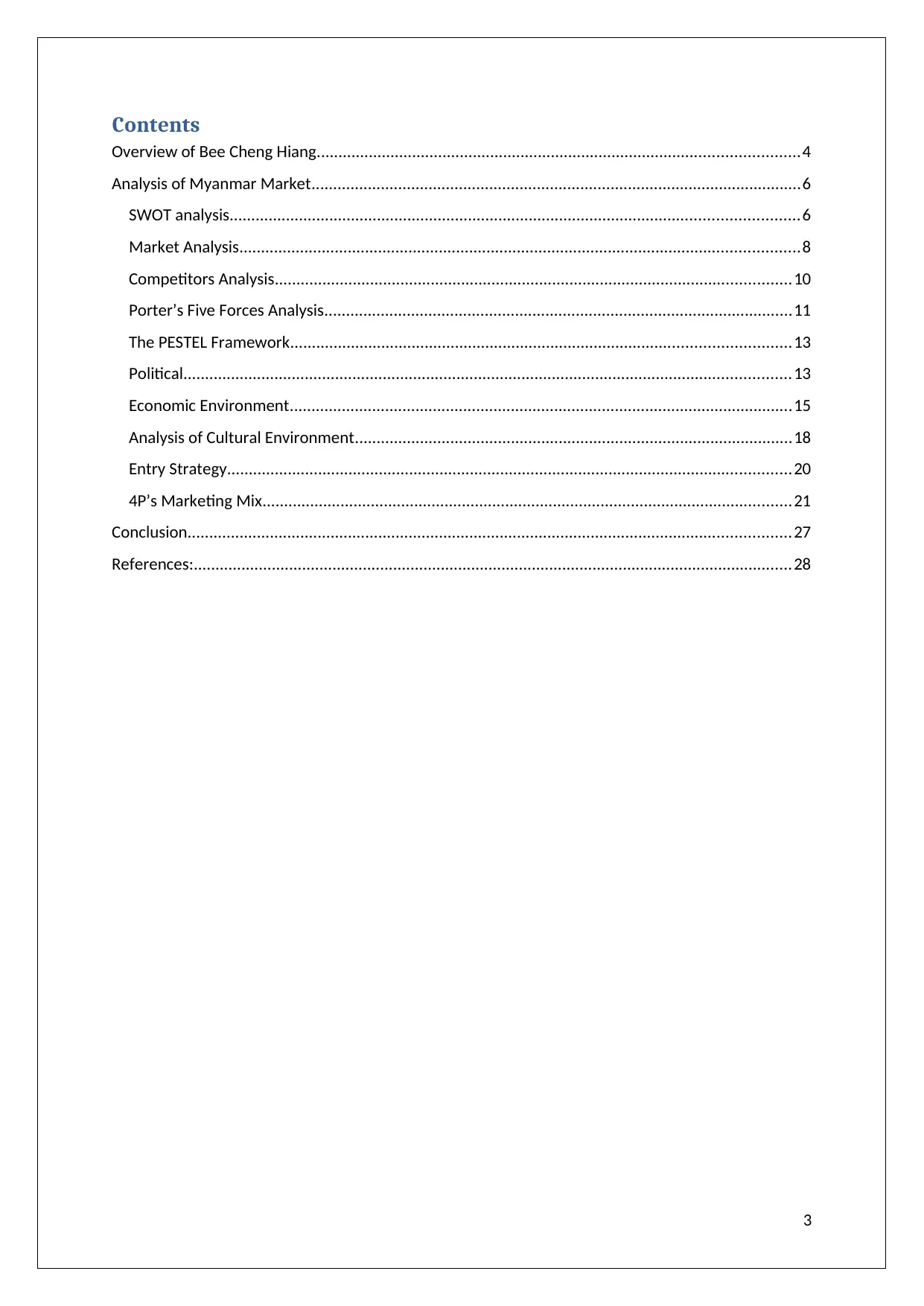
Contents
Overview of Bee Cheng Hiang...............................................................................................................4
Analysis of Myanmar Market.................................................................................................................6
SWOT analysis...................................................................................................................................6
Market Analysis.................................................................................................................................8
Competitors Analysis.......................................................................................................................10
Porter’s Five Forces Analysis............................................................................................................11
The PESTEL Framework...................................................................................................................13
Political............................................................................................................................................13
Economic Environment....................................................................................................................15
Analysis of Cultural Environment.....................................................................................................18
Entry Strategy..................................................................................................................................20
4P’s Marketing Mix..........................................................................................................................21
Conclusion...........................................................................................................................................27
References:..........................................................................................................................................28
3
Overview of Bee Cheng Hiang...............................................................................................................4
Analysis of Myanmar Market.................................................................................................................6
SWOT analysis...................................................................................................................................6
Market Analysis.................................................................................................................................8
Competitors Analysis.......................................................................................................................10
Porter’s Five Forces Analysis............................................................................................................11
The PESTEL Framework...................................................................................................................13
Political............................................................................................................................................13
Economic Environment....................................................................................................................15
Analysis of Cultural Environment.....................................................................................................18
Entry Strategy..................................................................................................................................20
4P’s Marketing Mix..........................................................................................................................21
Conclusion...........................................................................................................................................27
References:..........................................................................................................................................28
3
⊘ This is a preview!⊘
Do you want full access?
Subscribe today to unlock all pages.

Trusted by 1+ million students worldwide
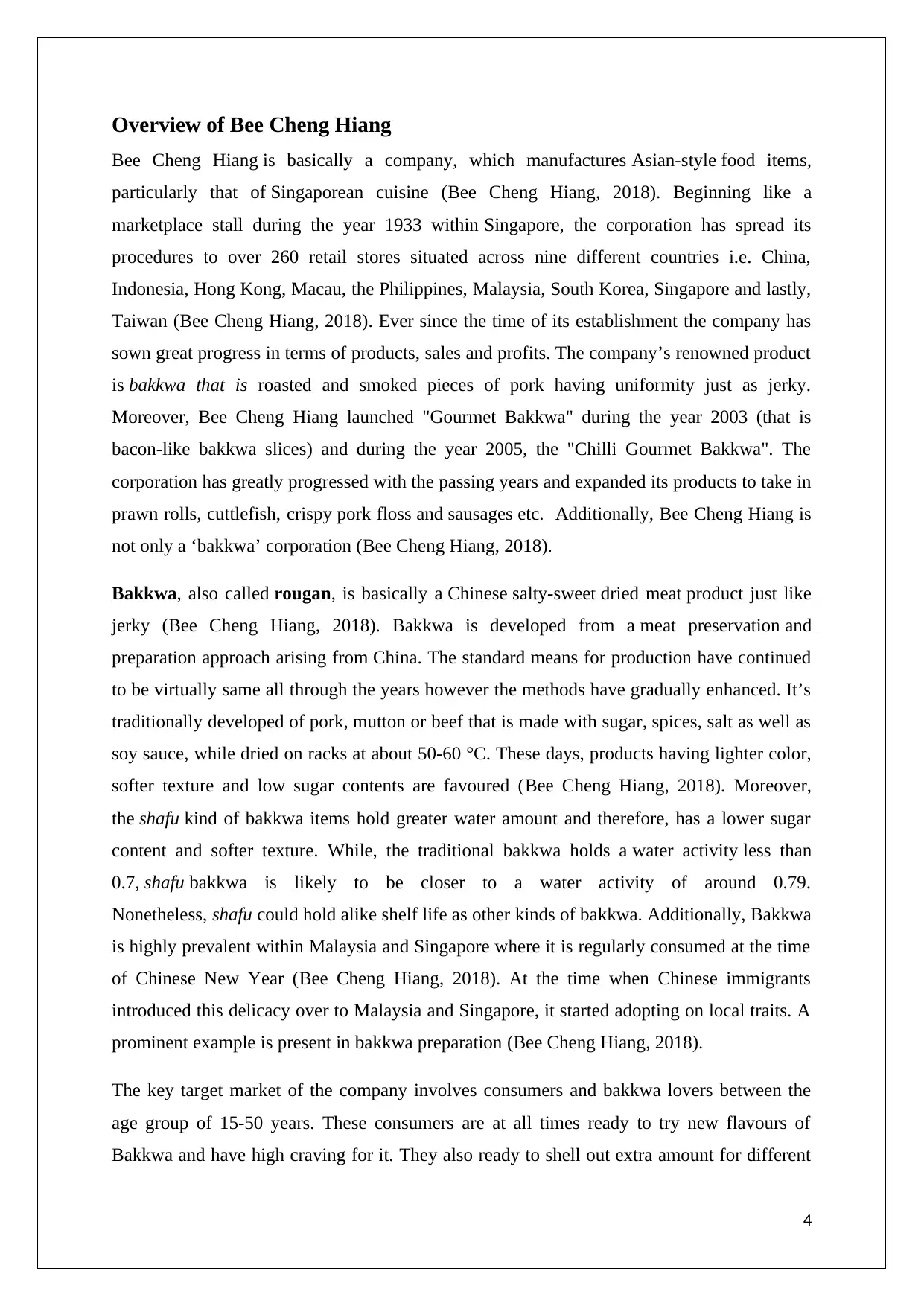
Overview of Bee Cheng Hiang
Bee Cheng Hiang is basically a company, which manufactures Asian-style food items,
particularly that of Singaporean cuisine (Bee Cheng Hiang, 2018). Beginning like a
marketplace stall during the year 1933 within Singapore, the corporation has spread its
procedures to over 260 retail stores situated across nine different countries i.e. China,
Indonesia, Hong Kong, Macau, the Philippines, Malaysia, South Korea, Singapore and lastly,
Taiwan (Bee Cheng Hiang, 2018). Ever since the time of its establishment the company has
sown great progress in terms of products, sales and profits. The company’s renowned product
is bakkwa that is roasted and smoked pieces of pork having uniformity just as jerky.
Moreover, Bee Cheng Hiang launched "Gourmet Bakkwa" during the year 2003 (that is
bacon-like bakkwa slices) and during the year 2005, the "Chilli Gourmet Bakkwa". The
corporation has greatly progressed with the passing years and expanded its products to take in
prawn rolls, cuttlefish, crispy pork floss and sausages etc. Additionally, Bee Cheng Hiang is
not only a ‘bakkwa’ corporation (Bee Cheng Hiang, 2018).
Bakkwa, also called rougan, is basically a Chinese salty-sweet dried meat product just like
jerky (Bee Cheng Hiang, 2018). Bakkwa is developed from a meat preservation and
preparation approach arising from China. The standard means for production have continued
to be virtually same all through the years however the methods have gradually enhanced. It’s
traditionally developed of pork, mutton or beef that is made with sugar, spices, salt as well as
soy sauce, while dried on racks at about 50-60 °C. These days, products having lighter color,
softer texture and low sugar contents are favoured (Bee Cheng Hiang, 2018). Moreover,
the shafu kind of bakkwa items hold greater water amount and therefore, has a lower sugar
content and softer texture. While, the traditional bakkwa holds a water activity less than
0.7, shafu bakkwa is likely to be closer to a water activity of around 0.79.
Nonetheless, shafu could hold alike shelf life as other kinds of bakkwa. Additionally, Bakkwa
is highly prevalent within Malaysia and Singapore where it is regularly consumed at the time
of Chinese New Year (Bee Cheng Hiang, 2018). At the time when Chinese immigrants
introduced this delicacy over to Malaysia and Singapore, it started adopting on local traits. A
prominent example is present in bakkwa preparation (Bee Cheng Hiang, 2018).
The key target market of the company involves consumers and bakkwa lovers between the
age group of 15-50 years. These consumers are at all times ready to try new flavours of
Bakkwa and have high craving for it. They also ready to shell out extra amount for different
4
Bee Cheng Hiang is basically a company, which manufactures Asian-style food items,
particularly that of Singaporean cuisine (Bee Cheng Hiang, 2018). Beginning like a
marketplace stall during the year 1933 within Singapore, the corporation has spread its
procedures to over 260 retail stores situated across nine different countries i.e. China,
Indonesia, Hong Kong, Macau, the Philippines, Malaysia, South Korea, Singapore and lastly,
Taiwan (Bee Cheng Hiang, 2018). Ever since the time of its establishment the company has
sown great progress in terms of products, sales and profits. The company’s renowned product
is bakkwa that is roasted and smoked pieces of pork having uniformity just as jerky.
Moreover, Bee Cheng Hiang launched "Gourmet Bakkwa" during the year 2003 (that is
bacon-like bakkwa slices) and during the year 2005, the "Chilli Gourmet Bakkwa". The
corporation has greatly progressed with the passing years and expanded its products to take in
prawn rolls, cuttlefish, crispy pork floss and sausages etc. Additionally, Bee Cheng Hiang is
not only a ‘bakkwa’ corporation (Bee Cheng Hiang, 2018).
Bakkwa, also called rougan, is basically a Chinese salty-sweet dried meat product just like
jerky (Bee Cheng Hiang, 2018). Bakkwa is developed from a meat preservation and
preparation approach arising from China. The standard means for production have continued
to be virtually same all through the years however the methods have gradually enhanced. It’s
traditionally developed of pork, mutton or beef that is made with sugar, spices, salt as well as
soy sauce, while dried on racks at about 50-60 °C. These days, products having lighter color,
softer texture and low sugar contents are favoured (Bee Cheng Hiang, 2018). Moreover,
the shafu kind of bakkwa items hold greater water amount and therefore, has a lower sugar
content and softer texture. While, the traditional bakkwa holds a water activity less than
0.7, shafu bakkwa is likely to be closer to a water activity of around 0.79.
Nonetheless, shafu could hold alike shelf life as other kinds of bakkwa. Additionally, Bakkwa
is highly prevalent within Malaysia and Singapore where it is regularly consumed at the time
of Chinese New Year (Bee Cheng Hiang, 2018). At the time when Chinese immigrants
introduced this delicacy over to Malaysia and Singapore, it started adopting on local traits. A
prominent example is present in bakkwa preparation (Bee Cheng Hiang, 2018).
The key target market of the company involves consumers and bakkwa lovers between the
age group of 15-50 years. These consumers are at all times ready to try new flavours of
Bakkwa and have high craving for it. They also ready to shell out extra amount for different
4
Paraphrase This Document
Need a fresh take? Get an instant paraphrase of this document with our AI Paraphraser
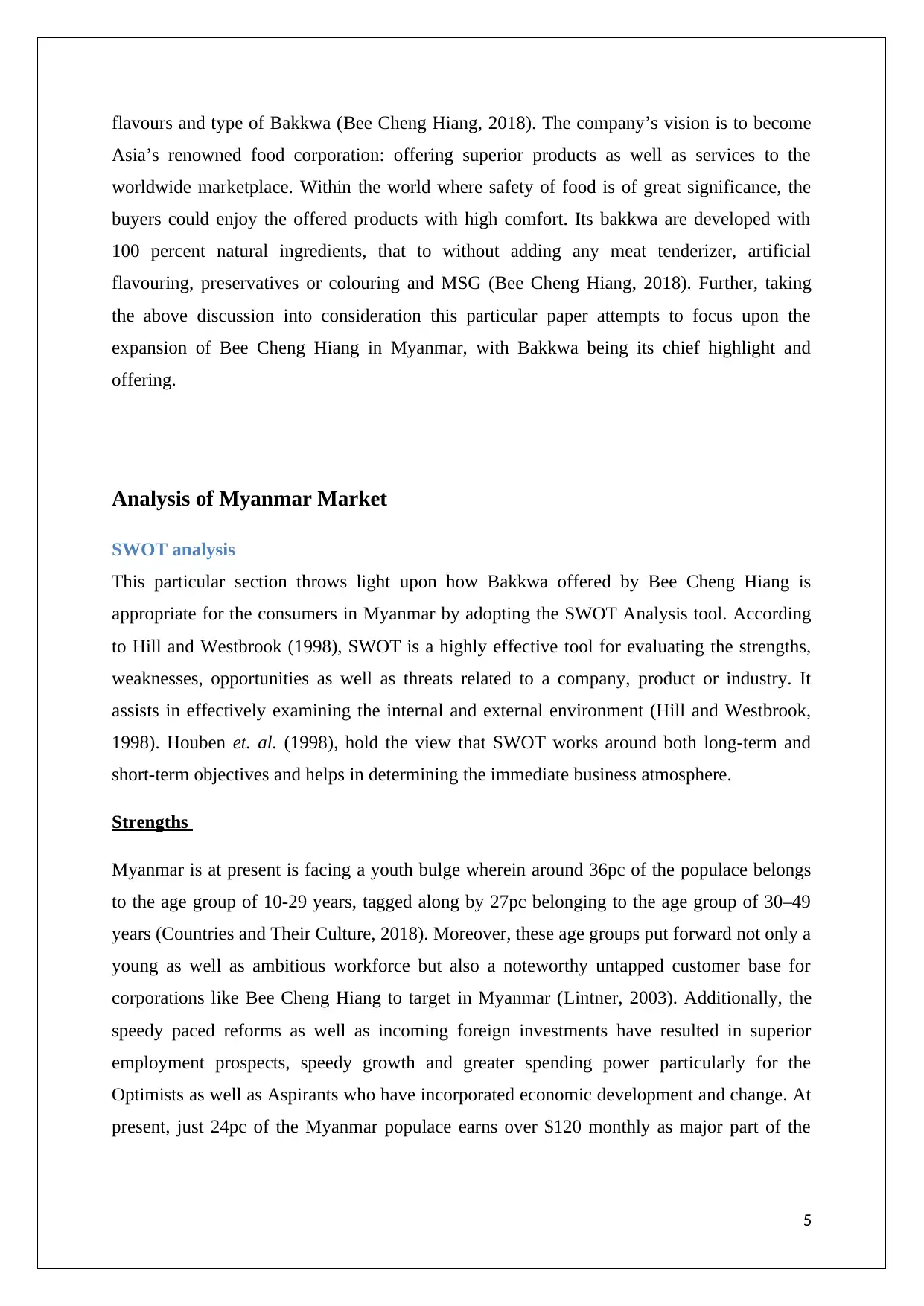
flavours and type of Bakkwa (Bee Cheng Hiang, 2018). The company’s vision is to become
Asia’s renowned food corporation: offering superior products as well as services to the
worldwide marketplace. Within the world where safety of food is of great significance, the
buyers could enjoy the offered products with high comfort. Its bakkwa are developed with
100 percent natural ingredients, that to without adding any meat tenderizer, artificial
flavouring, preservatives or colouring and MSG (Bee Cheng Hiang, 2018). Further, taking
the above discussion into consideration this particular paper attempts to focus upon the
expansion of Bee Cheng Hiang in Myanmar, with Bakkwa being its chief highlight and
offering.
Analysis of Myanmar Market
SWOT analysis
This particular section throws light upon how Bakkwa offered by Bee Cheng Hiang is
appropriate for the consumers in Myanmar by adopting the SWOT Analysis tool. According
to Hill and Westbrook (1998), SWOT is a highly effective tool for evaluating the strengths,
weaknesses, opportunities as well as threats related to a company, product or industry. It
assists in effectively examining the internal and external environment (Hill and Westbrook,
1998). Houben et. al. (1998), hold the view that SWOT works around both long-term and
short-term objectives and helps in determining the immediate business atmosphere.
Strengths
Myanmar is at present is facing a youth bulge wherein around 36pc of the populace belongs
to the age group of 10-29 years, tagged along by 27pc belonging to the age group of 30–49
years (Countries and Their Culture, 2018). Moreover, these age groups put forward not only a
young as well as ambitious workforce but also a noteworthy untapped customer base for
corporations like Bee Cheng Hiang to target in Myanmar (Lintner, 2003). Additionally, the
speedy paced reforms as well as incoming foreign investments have resulted in superior
employment prospects, speedy growth and greater spending power particularly for the
Optimists as well as Aspirants who have incorporated economic development and change. At
present, just 24pc of the Myanmar populace earns over $120 monthly as major part of the
5
Asia’s renowned food corporation: offering superior products as well as services to the
worldwide marketplace. Within the world where safety of food is of great significance, the
buyers could enjoy the offered products with high comfort. Its bakkwa are developed with
100 percent natural ingredients, that to without adding any meat tenderizer, artificial
flavouring, preservatives or colouring and MSG (Bee Cheng Hiang, 2018). Further, taking
the above discussion into consideration this particular paper attempts to focus upon the
expansion of Bee Cheng Hiang in Myanmar, with Bakkwa being its chief highlight and
offering.
Analysis of Myanmar Market
SWOT analysis
This particular section throws light upon how Bakkwa offered by Bee Cheng Hiang is
appropriate for the consumers in Myanmar by adopting the SWOT Analysis tool. According
to Hill and Westbrook (1998), SWOT is a highly effective tool for evaluating the strengths,
weaknesses, opportunities as well as threats related to a company, product or industry. It
assists in effectively examining the internal and external environment (Hill and Westbrook,
1998). Houben et. al. (1998), hold the view that SWOT works around both long-term and
short-term objectives and helps in determining the immediate business atmosphere.
Strengths
Myanmar is at present is facing a youth bulge wherein around 36pc of the populace belongs
to the age group of 10-29 years, tagged along by 27pc belonging to the age group of 30–49
years (Countries and Their Culture, 2018). Moreover, these age groups put forward not only a
young as well as ambitious workforce but also a noteworthy untapped customer base for
corporations like Bee Cheng Hiang to target in Myanmar (Lintner, 2003). Additionally, the
speedy paced reforms as well as incoming foreign investments have resulted in superior
employment prospects, speedy growth and greater spending power particularly for the
Optimists as well as Aspirants who have incorporated economic development and change. At
present, just 24pc of the Myanmar populace earns over $120 monthly as major part of the
5
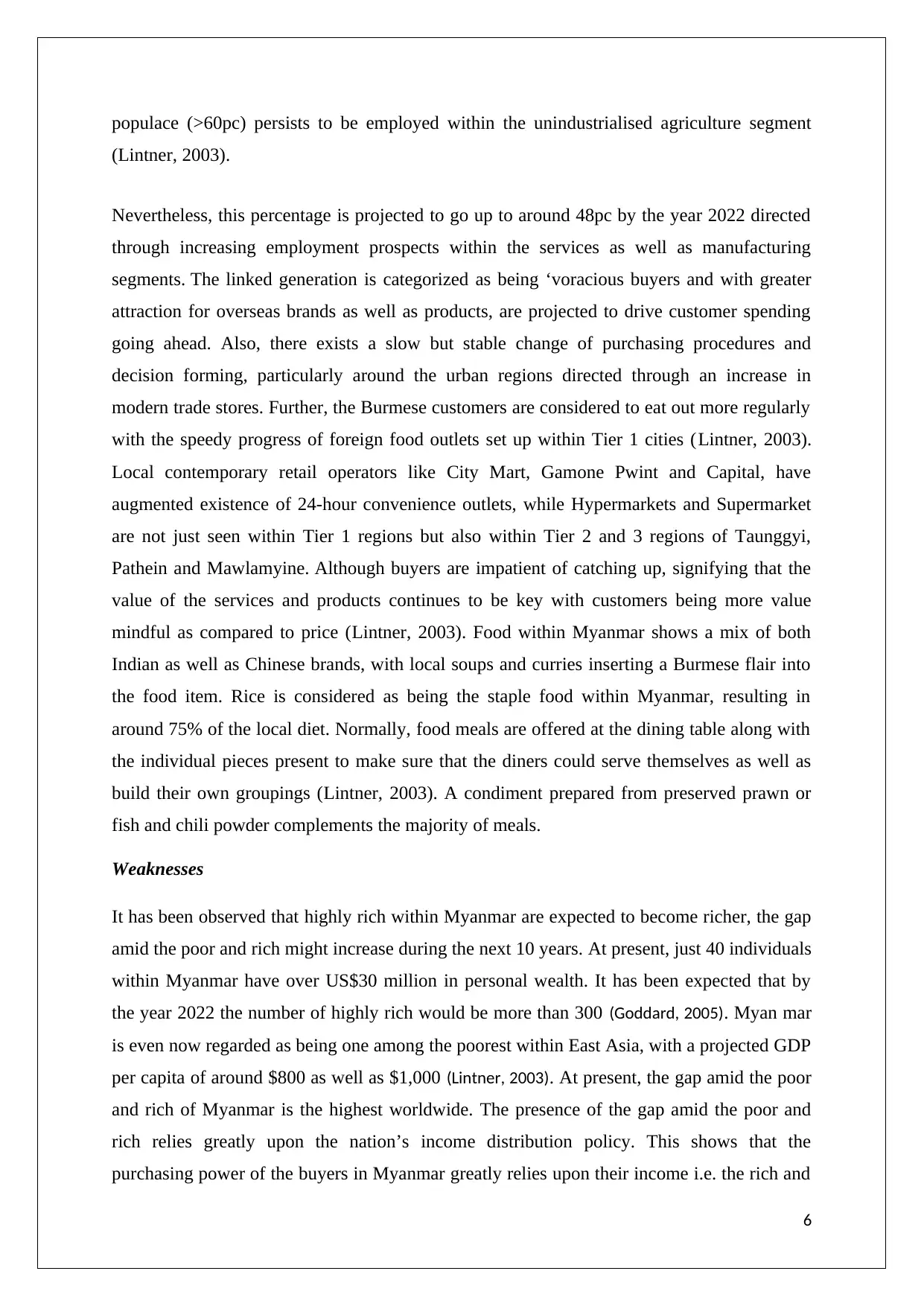
populace (>60pc) persists to be employed within the unindustrialised agriculture segment
(Lintner, 2003).
Nevertheless, this percentage is projected to go up to around 48pc by the year 2022 directed
through increasing employment prospects within the services as well as manufacturing
segments. The linked generation is categorized as being ‘voracious buyers and with greater
attraction for overseas brands as well as products, are projected to drive customer spending
going ahead. Also, there exists a slow but stable change of purchasing procedures and
decision forming, particularly around the urban regions directed through an increase in
modern trade stores. Further, the Burmese customers are considered to eat out more regularly
with the speedy progress of foreign food outlets set up within Tier 1 cities (Lintner, 2003).
Local contemporary retail operators like City Mart, Gamone Pwint and Capital, have
augmented existence of 24-hour convenience outlets, while Hypermarkets and Supermarket
are not just seen within Tier 1 regions but also within Tier 2 and 3 regions of Taunggyi,
Pathein and Mawlamyine. Although buyers are impatient of catching up, signifying that the
value of the services and products continues to be key with customers being more value
mindful as compared to price (Lintner, 2003). Food within Myanmar shows a mix of both
Indian as well as Chinese brands, with local soups and curries inserting a Burmese flair into
the food item. Rice is considered as being the staple food within Myanmar, resulting in
around 75% of the local diet. Normally, food meals are offered at the dining table along with
the individual pieces present to make sure that the diners could serve themselves as well as
build their own groupings (Lintner, 2003). A condiment prepared from preserved prawn or
fish and chili powder complements the majority of meals.
Weaknesses
It has been observed that highly rich within Myanmar are expected to become richer, the gap
amid the poor and rich might increase during the next 10 years. At present, just 40 individuals
within Myanmar have over US$30 million in personal wealth. It has been expected that by
the year 2022 the number of highly rich would be more than 300 (Goddard, 2005). Myan mar
is even now regarded as being one among the poorest within East Asia, with a projected GDP
per capita of around $800 as well as $1,000 (Lintner, 2003). At present, the gap amid the poor
and rich of Myanmar is the highest worldwide. The presence of the gap amid the poor and
rich relies greatly upon the nation’s income distribution policy. This shows that the
purchasing power of the buyers in Myanmar greatly relies upon their income i.e. the rich and
6
(Lintner, 2003).
Nevertheless, this percentage is projected to go up to around 48pc by the year 2022 directed
through increasing employment prospects within the services as well as manufacturing
segments. The linked generation is categorized as being ‘voracious buyers and with greater
attraction for overseas brands as well as products, are projected to drive customer spending
going ahead. Also, there exists a slow but stable change of purchasing procedures and
decision forming, particularly around the urban regions directed through an increase in
modern trade stores. Further, the Burmese customers are considered to eat out more regularly
with the speedy progress of foreign food outlets set up within Tier 1 cities (Lintner, 2003).
Local contemporary retail operators like City Mart, Gamone Pwint and Capital, have
augmented existence of 24-hour convenience outlets, while Hypermarkets and Supermarket
are not just seen within Tier 1 regions but also within Tier 2 and 3 regions of Taunggyi,
Pathein and Mawlamyine. Although buyers are impatient of catching up, signifying that the
value of the services and products continues to be key with customers being more value
mindful as compared to price (Lintner, 2003). Food within Myanmar shows a mix of both
Indian as well as Chinese brands, with local soups and curries inserting a Burmese flair into
the food item. Rice is considered as being the staple food within Myanmar, resulting in
around 75% of the local diet. Normally, food meals are offered at the dining table along with
the individual pieces present to make sure that the diners could serve themselves as well as
build their own groupings (Lintner, 2003). A condiment prepared from preserved prawn or
fish and chili powder complements the majority of meals.
Weaknesses
It has been observed that highly rich within Myanmar are expected to become richer, the gap
amid the poor and rich might increase during the next 10 years. At present, just 40 individuals
within Myanmar have over US$30 million in personal wealth. It has been expected that by
the year 2022 the number of highly rich would be more than 300 (Goddard, 2005). Myan mar
is even now regarded as being one among the poorest within East Asia, with a projected GDP
per capita of around $800 as well as $1,000 (Lintner, 2003). At present, the gap amid the poor
and rich of Myanmar is the highest worldwide. The presence of the gap amid the poor and
rich relies greatly upon the nation’s income distribution policy. This shows that the
purchasing power of the buyers in Myanmar greatly relies upon their income i.e. the rich and
6
⊘ This is a preview!⊘
Do you want full access?
Subscribe today to unlock all pages.

Trusted by 1+ million students worldwide
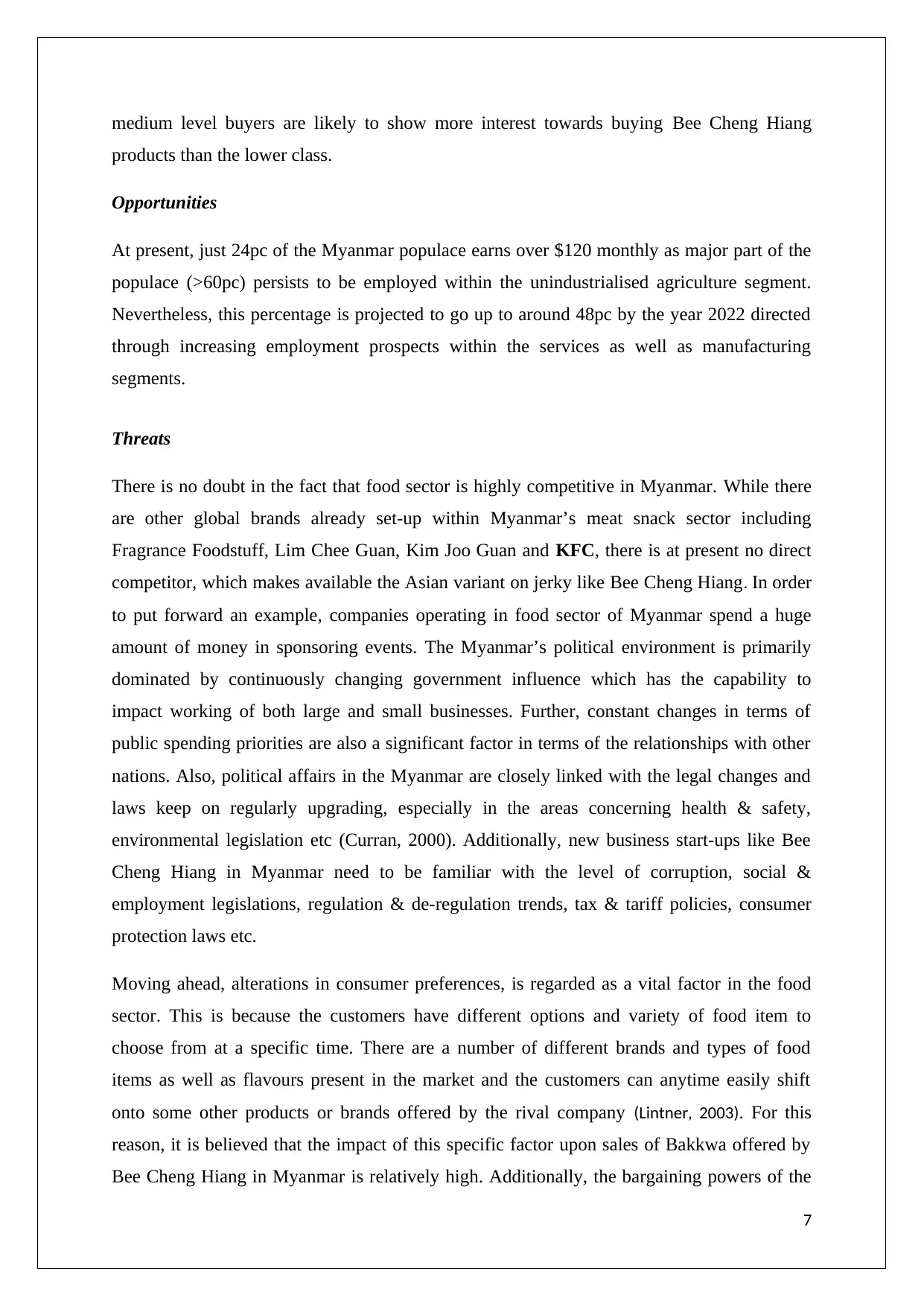
medium level buyers are likely to show more interest towards buying Bee Cheng Hiang
products than the lower class.
Opportunities
At present, just 24pc of the Myanmar populace earns over $120 monthly as major part of the
populace (>60pc) persists to be employed within the unindustrialised agriculture segment.
Nevertheless, this percentage is projected to go up to around 48pc by the year 2022 directed
through increasing employment prospects within the services as well as manufacturing
segments.
Threats
There is no doubt in the fact that food sector is highly competitive in Myanmar. While there
are other global brands already set-up within Myanmar’s meat snack sector including
Fragrance Foodstuff, Lim Chee Guan, Kim Joo Guan and KFC, there is at present no direct
competitor, which makes available the Asian variant on jerky like Bee Cheng Hiang. In order
to put forward an example, companies operating in food sector of Myanmar spend a huge
amount of money in sponsoring events. The Myanmar’s political environment is primarily
dominated by continuously changing government influence which has the capability to
impact working of both large and small businesses. Further, constant changes in terms of
public spending priorities are also a significant factor in terms of the relationships with other
nations. Also, political affairs in the Myanmar are closely linked with the legal changes and
laws keep on regularly upgrading, especially in the areas concerning health & safety,
environmental legislation etc (Curran, 2000). Additionally, new business start-ups like Bee
Cheng Hiang in Myanmar need to be familiar with the level of corruption, social &
employment legislations, regulation & de-regulation trends, tax & tariff policies, consumer
protection laws etc.
Moving ahead, alterations in consumer preferences, is regarded as a vital factor in the food
sector. This is because the customers have different options and variety of food item to
choose from at a specific time. There are a number of different brands and types of food
items as well as flavours present in the market and the customers can anytime easily shift
onto some other products or brands offered by the rival company (Lintner, 2003). For this
reason, it is believed that the impact of this specific factor upon sales of Bakkwa offered by
Bee Cheng Hiang in Myanmar is relatively high. Additionally, the bargaining powers of the
7
products than the lower class.
Opportunities
At present, just 24pc of the Myanmar populace earns over $120 monthly as major part of the
populace (>60pc) persists to be employed within the unindustrialised agriculture segment.
Nevertheless, this percentage is projected to go up to around 48pc by the year 2022 directed
through increasing employment prospects within the services as well as manufacturing
segments.
Threats
There is no doubt in the fact that food sector is highly competitive in Myanmar. While there
are other global brands already set-up within Myanmar’s meat snack sector including
Fragrance Foodstuff, Lim Chee Guan, Kim Joo Guan and KFC, there is at present no direct
competitor, which makes available the Asian variant on jerky like Bee Cheng Hiang. In order
to put forward an example, companies operating in food sector of Myanmar spend a huge
amount of money in sponsoring events. The Myanmar’s political environment is primarily
dominated by continuously changing government influence which has the capability to
impact working of both large and small businesses. Further, constant changes in terms of
public spending priorities are also a significant factor in terms of the relationships with other
nations. Also, political affairs in the Myanmar are closely linked with the legal changes and
laws keep on regularly upgrading, especially in the areas concerning health & safety,
environmental legislation etc (Curran, 2000). Additionally, new business start-ups like Bee
Cheng Hiang in Myanmar need to be familiar with the level of corruption, social &
employment legislations, regulation & de-regulation trends, tax & tariff policies, consumer
protection laws etc.
Moving ahead, alterations in consumer preferences, is regarded as a vital factor in the food
sector. This is because the customers have different options and variety of food item to
choose from at a specific time. There are a number of different brands and types of food
items as well as flavours present in the market and the customers can anytime easily shift
onto some other products or brands offered by the rival company (Lintner, 2003). For this
reason, it is believed that the impact of this specific factor upon sales of Bakkwa offered by
Bee Cheng Hiang in Myanmar is relatively high. Additionally, the bargaining powers of the
7
Paraphrase This Document
Need a fresh take? Get an instant paraphrase of this document with our AI Paraphraser
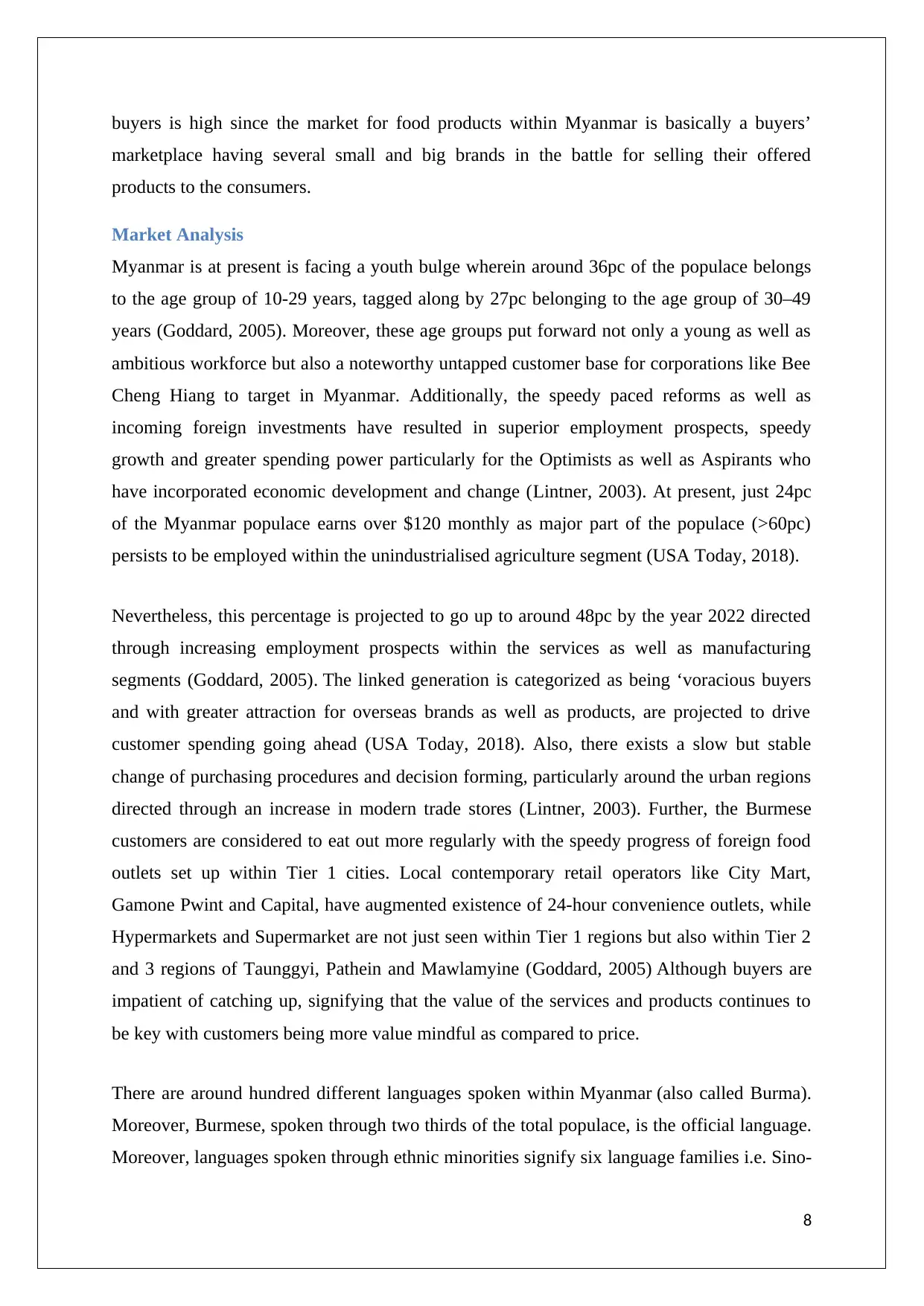
buyers is high since the market for food products within Myanmar is basically a buyers’
marketplace having several small and big brands in the battle for selling their offered
products to the consumers.
Market Analysis
Myanmar is at present is facing a youth bulge wherein around 36pc of the populace belongs
to the age group of 10-29 years, tagged along by 27pc belonging to the age group of 30–49
years (Goddard, 2005). Moreover, these age groups put forward not only a young as well as
ambitious workforce but also a noteworthy untapped customer base for corporations like Bee
Cheng Hiang to target in Myanmar. Additionally, the speedy paced reforms as well as
incoming foreign investments have resulted in superior employment prospects, speedy
growth and greater spending power particularly for the Optimists as well as Aspirants who
have incorporated economic development and change (Lintner, 2003). At present, just 24pc
of the Myanmar populace earns over $120 monthly as major part of the populace (>60pc)
persists to be employed within the unindustrialised agriculture segment (USA Today, 2018).
Nevertheless, this percentage is projected to go up to around 48pc by the year 2022 directed
through increasing employment prospects within the services as well as manufacturing
segments (Goddard, 2005). The linked generation is categorized as being ‘voracious buyers
and with greater attraction for overseas brands as well as products, are projected to drive
customer spending going ahead (USA Today, 2018). Also, there exists a slow but stable
change of purchasing procedures and decision forming, particularly around the urban regions
directed through an increase in modern trade stores (Lintner, 2003). Further, the Burmese
customers are considered to eat out more regularly with the speedy progress of foreign food
outlets set up within Tier 1 cities. Local contemporary retail operators like City Mart,
Gamone Pwint and Capital, have augmented existence of 24-hour convenience outlets, while
Hypermarkets and Supermarket are not just seen within Tier 1 regions but also within Tier 2
and 3 regions of Taunggyi, Pathein and Mawlamyine (Goddard, 2005) Although buyers are
impatient of catching up, signifying that the value of the services and products continues to
be key with customers being more value mindful as compared to price.
There are around hundred different languages spoken within Myanmar (also called Burma).
Moreover, Burmese, spoken through two thirds of the total populace, is the official language.
Moreover, languages spoken through ethnic minorities signify six language families i.e. Sino-
8
marketplace having several small and big brands in the battle for selling their offered
products to the consumers.
Market Analysis
Myanmar is at present is facing a youth bulge wherein around 36pc of the populace belongs
to the age group of 10-29 years, tagged along by 27pc belonging to the age group of 30–49
years (Goddard, 2005). Moreover, these age groups put forward not only a young as well as
ambitious workforce but also a noteworthy untapped customer base for corporations like Bee
Cheng Hiang to target in Myanmar. Additionally, the speedy paced reforms as well as
incoming foreign investments have resulted in superior employment prospects, speedy
growth and greater spending power particularly for the Optimists as well as Aspirants who
have incorporated economic development and change (Lintner, 2003). At present, just 24pc
of the Myanmar populace earns over $120 monthly as major part of the populace (>60pc)
persists to be employed within the unindustrialised agriculture segment (USA Today, 2018).
Nevertheless, this percentage is projected to go up to around 48pc by the year 2022 directed
through increasing employment prospects within the services as well as manufacturing
segments (Goddard, 2005). The linked generation is categorized as being ‘voracious buyers
and with greater attraction for overseas brands as well as products, are projected to drive
customer spending going ahead (USA Today, 2018). Also, there exists a slow but stable
change of purchasing procedures and decision forming, particularly around the urban regions
directed through an increase in modern trade stores (Lintner, 2003). Further, the Burmese
customers are considered to eat out more regularly with the speedy progress of foreign food
outlets set up within Tier 1 cities. Local contemporary retail operators like City Mart,
Gamone Pwint and Capital, have augmented existence of 24-hour convenience outlets, while
Hypermarkets and Supermarket are not just seen within Tier 1 regions but also within Tier 2
and 3 regions of Taunggyi, Pathein and Mawlamyine (Goddard, 2005) Although buyers are
impatient of catching up, signifying that the value of the services and products continues to
be key with customers being more value mindful as compared to price.
There are around hundred different languages spoken within Myanmar (also called Burma).
Moreover, Burmese, spoken through two thirds of the total populace, is the official language.
Moreover, languages spoken through ethnic minorities signify six language families i.e. Sino-
8
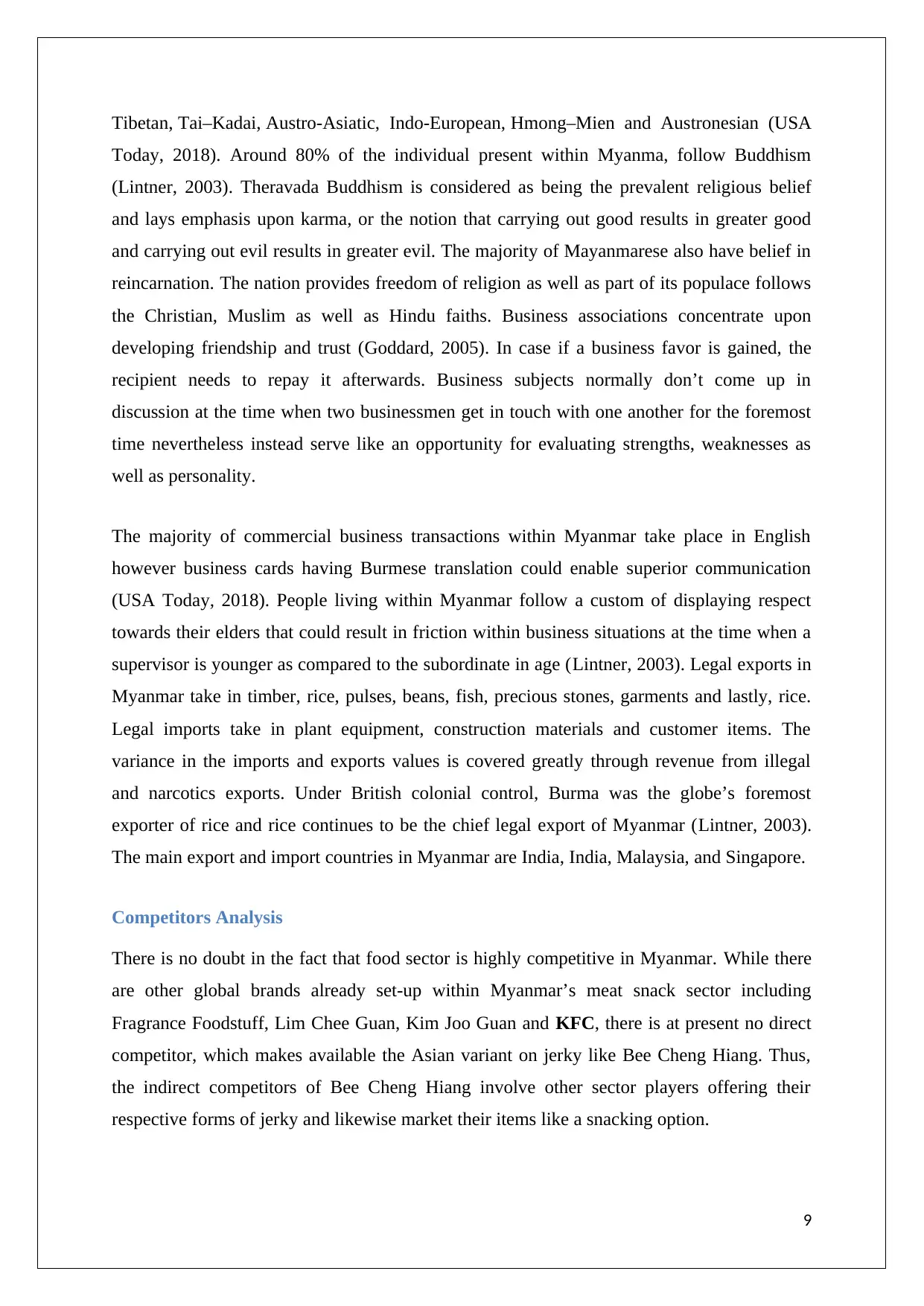
Tibetan, Tai–Kadai, Austro-Asiatic, Indo-European, Hmong–Mien and Austronesian (USA
Today, 2018). Around 80% of the individual present within Myanma, follow Buddhism
(Lintner, 2003). Theravada Buddhism is considered as being the prevalent religious belief
and lays emphasis upon karma, or the notion that carrying out good results in greater good
and carrying out evil results in greater evil. The majority of Mayanmarese also have belief in
reincarnation. The nation provides freedom of religion as well as part of its populace follows
the Christian, Muslim as well as Hindu faiths. Business associations concentrate upon
developing friendship and trust (Goddard, 2005). In case if a business favor is gained, the
recipient needs to repay it afterwards. Business subjects normally don’t come up in
discussion at the time when two businessmen get in touch with one another for the foremost
time nevertheless instead serve like an opportunity for evaluating strengths, weaknesses as
well as personality.
The majority of commercial business transactions within Myanmar take place in English
however business cards having Burmese translation could enable superior communication
(USA Today, 2018). People living within Myanmar follow a custom of displaying respect
towards their elders that could result in friction within business situations at the time when a
supervisor is younger as compared to the subordinate in age (Lintner, 2003). Legal exports in
Myanmar take in timber, rice, pulses, beans, fish, precious stones, garments and lastly, rice.
Legal imports take in plant equipment, construction materials and customer items. The
variance in the imports and exports values is covered greatly through revenue from illegal
and narcotics exports. Under British colonial control, Burma was the globe’s foremost
exporter of rice and rice continues to be the chief legal export of Myanmar (Lintner, 2003).
The main export and import countries in Myanmar are India, India, Malaysia, and Singapore.
Competitors Analysis
There is no doubt in the fact that food sector is highly competitive in Myanmar. While there
are other global brands already set-up within Myanmar’s meat snack sector including
Fragrance Foodstuff, Lim Chee Guan, Kim Joo Guan and KFC, there is at present no direct
competitor, which makes available the Asian variant on jerky like Bee Cheng Hiang. Thus,
the indirect competitors of Bee Cheng Hiang involve other sector players offering their
respective forms of jerky and likewise market their items like a snacking option.
9
Today, 2018). Around 80% of the individual present within Myanma, follow Buddhism
(Lintner, 2003). Theravada Buddhism is considered as being the prevalent religious belief
and lays emphasis upon karma, or the notion that carrying out good results in greater good
and carrying out evil results in greater evil. The majority of Mayanmarese also have belief in
reincarnation. The nation provides freedom of religion as well as part of its populace follows
the Christian, Muslim as well as Hindu faiths. Business associations concentrate upon
developing friendship and trust (Goddard, 2005). In case if a business favor is gained, the
recipient needs to repay it afterwards. Business subjects normally don’t come up in
discussion at the time when two businessmen get in touch with one another for the foremost
time nevertheless instead serve like an opportunity for evaluating strengths, weaknesses as
well as personality.
The majority of commercial business transactions within Myanmar take place in English
however business cards having Burmese translation could enable superior communication
(USA Today, 2018). People living within Myanmar follow a custom of displaying respect
towards their elders that could result in friction within business situations at the time when a
supervisor is younger as compared to the subordinate in age (Lintner, 2003). Legal exports in
Myanmar take in timber, rice, pulses, beans, fish, precious stones, garments and lastly, rice.
Legal imports take in plant equipment, construction materials and customer items. The
variance in the imports and exports values is covered greatly through revenue from illegal
and narcotics exports. Under British colonial control, Burma was the globe’s foremost
exporter of rice and rice continues to be the chief legal export of Myanmar (Lintner, 2003).
The main export and import countries in Myanmar are India, India, Malaysia, and Singapore.
Competitors Analysis
There is no doubt in the fact that food sector is highly competitive in Myanmar. While there
are other global brands already set-up within Myanmar’s meat snack sector including
Fragrance Foodstuff, Lim Chee Guan, Kim Joo Guan and KFC, there is at present no direct
competitor, which makes available the Asian variant on jerky like Bee Cheng Hiang. Thus,
the indirect competitors of Bee Cheng Hiang involve other sector players offering their
respective forms of jerky and likewise market their items like a snacking option.
9
⊘ This is a preview!⊘
Do you want full access?
Subscribe today to unlock all pages.

Trusted by 1+ million students worldwide
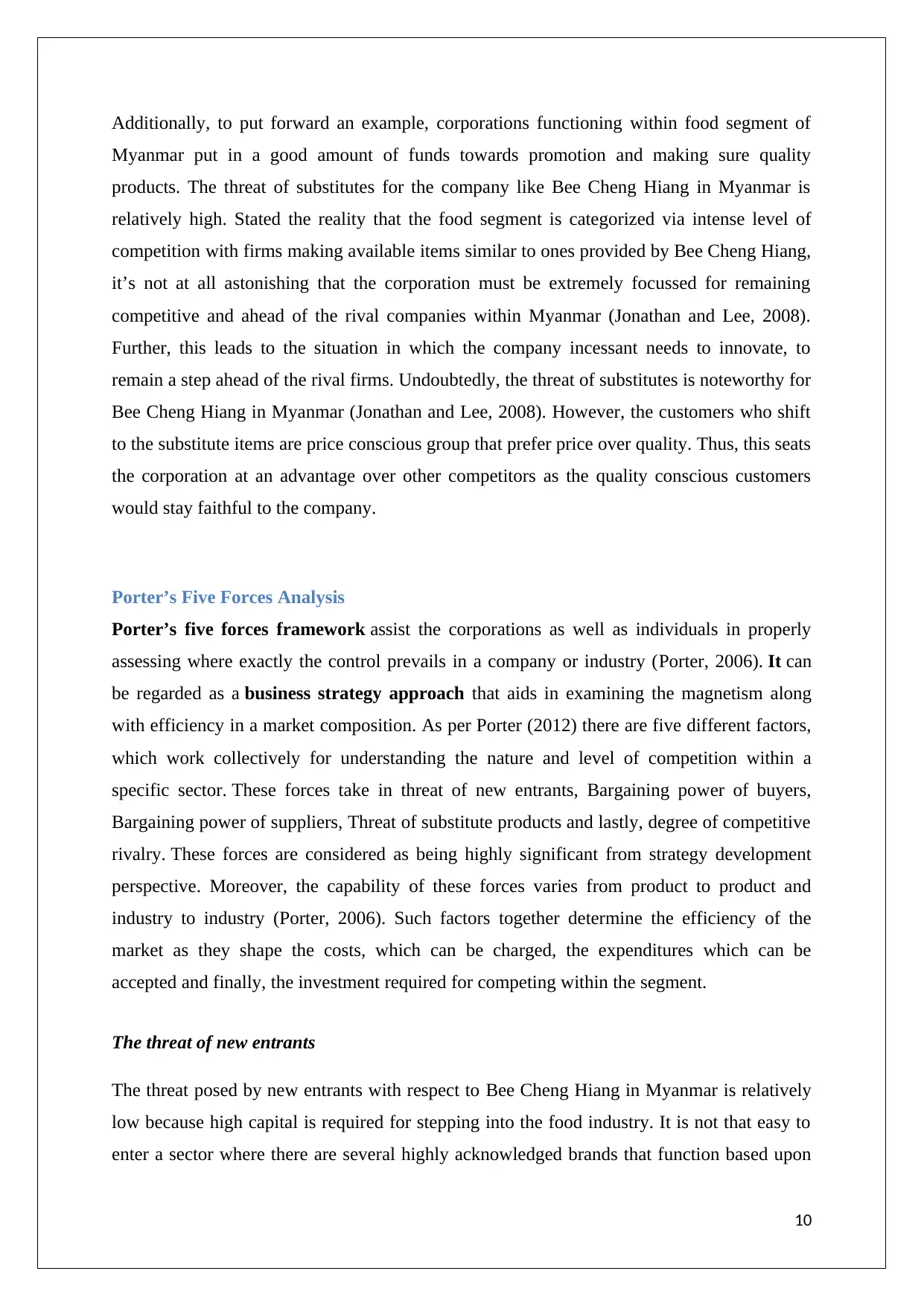
Additionally, to put forward an example, corporations functioning within food segment of
Myanmar put in a good amount of funds towards promotion and making sure quality
products. The threat of substitutes for the company like Bee Cheng Hiang in Myanmar is
relatively high. Stated the reality that the food segment is categorized via intense level of
competition with firms making available items similar to ones provided by Bee Cheng Hiang,
it’s not at all astonishing that the corporation must be extremely focussed for remaining
competitive and ahead of the rival companies within Myanmar (Jonathan and Lee, 2008).
Further, this leads to the situation in which the company incessant needs to innovate, to
remain a step ahead of the rival firms. Undoubtedly, the threat of substitutes is noteworthy for
Bee Cheng Hiang in Myanmar (Jonathan and Lee, 2008). However, the customers who shift
to the substitute items are price conscious group that prefer price over quality. Thus, this seats
the corporation at an advantage over other competitors as the quality conscious customers
would stay faithful to the company.
Porter’s Five Forces Analysis
Porter’s five forces framework assist the corporations as well as individuals in properly
assessing where exactly the control prevails in a company or industry (Porter, 2006). It can
be regarded as a business strategy approach that aids in examining the magnetism along
with efficiency in a market composition. As per Porter (2012) there are five different factors,
which work collectively for understanding the nature and level of competition within a
specific sector. These forces take in threat of new entrants, Bargaining power of buyers,
Bargaining power of suppliers, Threat of substitute products and lastly, degree of competitive
rivalry. These forces are considered as being highly significant from strategy development
perspective. Moreover, the capability of these forces varies from product to product and
industry to industry (Porter, 2006). Such factors together determine the efficiency of the
market as they shape the costs, which can be charged, the expenditures which can be
accepted and finally, the investment required for competing within the segment.
The threat of new entrants
The threat posed by new entrants with respect to Bee Cheng Hiang in Myanmar is relatively
low because high capital is required for stepping into the food industry. It is not that easy to
enter a sector where there are several highly acknowledged brands that function based upon
10
Myanmar put in a good amount of funds towards promotion and making sure quality
products. The threat of substitutes for the company like Bee Cheng Hiang in Myanmar is
relatively high. Stated the reality that the food segment is categorized via intense level of
competition with firms making available items similar to ones provided by Bee Cheng Hiang,
it’s not at all astonishing that the corporation must be extremely focussed for remaining
competitive and ahead of the rival companies within Myanmar (Jonathan and Lee, 2008).
Further, this leads to the situation in which the company incessant needs to innovate, to
remain a step ahead of the rival firms. Undoubtedly, the threat of substitutes is noteworthy for
Bee Cheng Hiang in Myanmar (Jonathan and Lee, 2008). However, the customers who shift
to the substitute items are price conscious group that prefer price over quality. Thus, this seats
the corporation at an advantage over other competitors as the quality conscious customers
would stay faithful to the company.
Porter’s Five Forces Analysis
Porter’s five forces framework assist the corporations as well as individuals in properly
assessing where exactly the control prevails in a company or industry (Porter, 2006). It can
be regarded as a business strategy approach that aids in examining the magnetism along
with efficiency in a market composition. As per Porter (2012) there are five different factors,
which work collectively for understanding the nature and level of competition within a
specific sector. These forces take in threat of new entrants, Bargaining power of buyers,
Bargaining power of suppliers, Threat of substitute products and lastly, degree of competitive
rivalry. These forces are considered as being highly significant from strategy development
perspective. Moreover, the capability of these forces varies from product to product and
industry to industry (Porter, 2006). Such factors together determine the efficiency of the
market as they shape the costs, which can be charged, the expenditures which can be
accepted and finally, the investment required for competing within the segment.
The threat of new entrants
The threat posed by new entrants with respect to Bee Cheng Hiang in Myanmar is relatively
low because high capital is required for stepping into the food industry. It is not that easy to
enter a sector where there are several highly acknowledged brands that function based upon
10
Paraphrase This Document
Need a fresh take? Get an instant paraphrase of this document with our AI Paraphraser
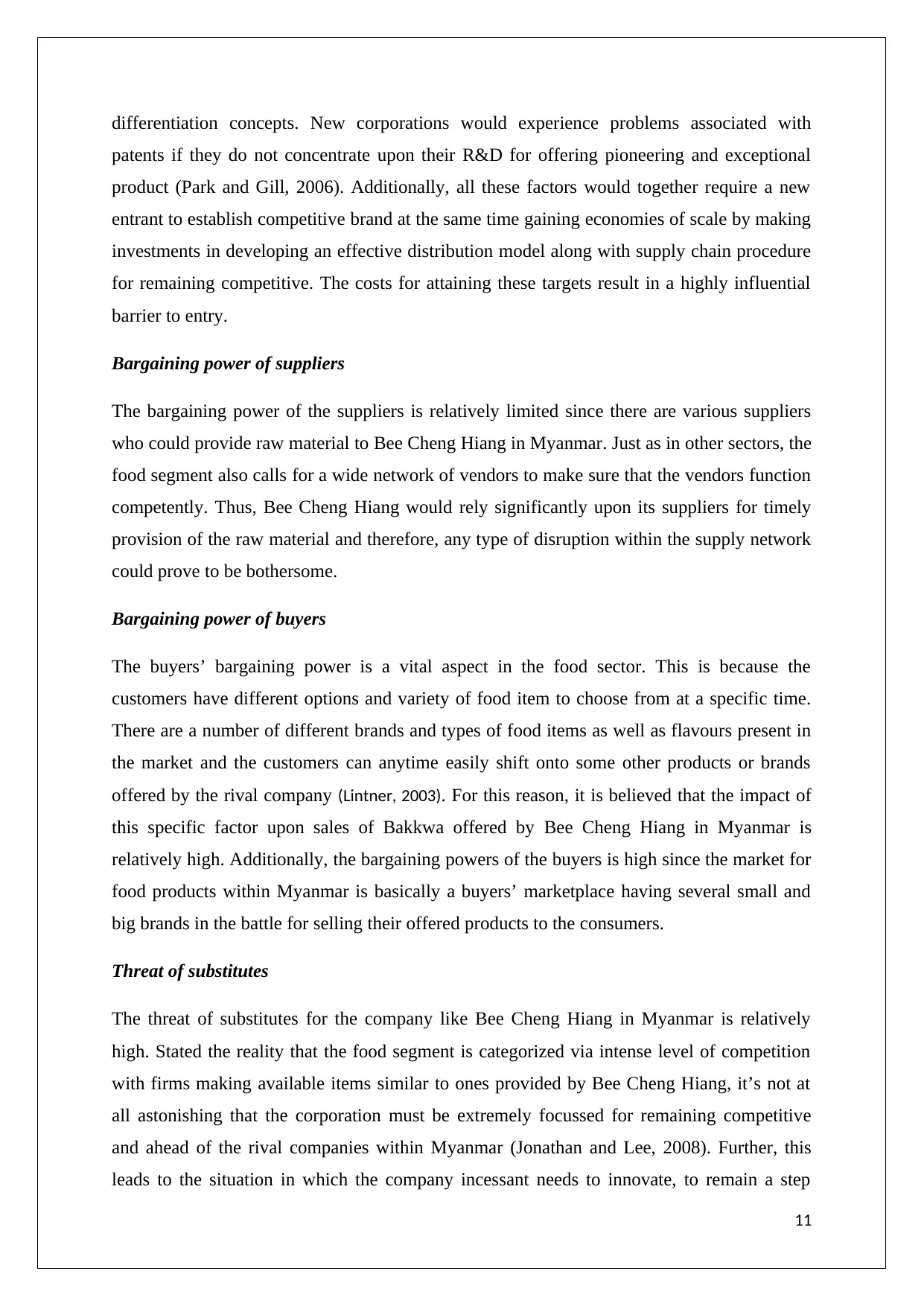
differentiation concepts. New corporations would experience problems associated with
patents if they do not concentrate upon their R&D for offering pioneering and exceptional
product (Park and Gill, 2006). Additionally, all these factors would together require a new
entrant to establish competitive brand at the same time gaining economies of scale by making
investments in developing an effective distribution model along with supply chain procedure
for remaining competitive. The costs for attaining these targets result in a highly influential
barrier to entry.
Bargaining power of suppliers
The bargaining power of the suppliers is relatively limited since there are various suppliers
who could provide raw material to Bee Cheng Hiang in Myanmar. Just as in other sectors, the
food segment also calls for a wide network of vendors to make sure that the vendors function
competently. Thus, Bee Cheng Hiang would rely significantly upon its suppliers for timely
provision of the raw material and therefore, any type of disruption within the supply network
could prove to be bothersome.
Bargaining power of buyers
The buyers’ bargaining power is a vital aspect in the food sector. This is because the
customers have different options and variety of food item to choose from at a specific time.
There are a number of different brands and types of food items as well as flavours present in
the market and the customers can anytime easily shift onto some other products or brands
offered by the rival company (Lintner, 2003). For this reason, it is believed that the impact of
this specific factor upon sales of Bakkwa offered by Bee Cheng Hiang in Myanmar is
relatively high. Additionally, the bargaining powers of the buyers is high since the market for
food products within Myanmar is basically a buyers’ marketplace having several small and
big brands in the battle for selling their offered products to the consumers.
Threat of substitutes
The threat of substitutes for the company like Bee Cheng Hiang in Myanmar is relatively
high. Stated the reality that the food segment is categorized via intense level of competition
with firms making available items similar to ones provided by Bee Cheng Hiang, it’s not at
all astonishing that the corporation must be extremely focussed for remaining competitive
and ahead of the rival companies within Myanmar (Jonathan and Lee, 2008). Further, this
leads to the situation in which the company incessant needs to innovate, to remain a step
11
patents if they do not concentrate upon their R&D for offering pioneering and exceptional
product (Park and Gill, 2006). Additionally, all these factors would together require a new
entrant to establish competitive brand at the same time gaining economies of scale by making
investments in developing an effective distribution model along with supply chain procedure
for remaining competitive. The costs for attaining these targets result in a highly influential
barrier to entry.
Bargaining power of suppliers
The bargaining power of the suppliers is relatively limited since there are various suppliers
who could provide raw material to Bee Cheng Hiang in Myanmar. Just as in other sectors, the
food segment also calls for a wide network of vendors to make sure that the vendors function
competently. Thus, Bee Cheng Hiang would rely significantly upon its suppliers for timely
provision of the raw material and therefore, any type of disruption within the supply network
could prove to be bothersome.
Bargaining power of buyers
The buyers’ bargaining power is a vital aspect in the food sector. This is because the
customers have different options and variety of food item to choose from at a specific time.
There are a number of different brands and types of food items as well as flavours present in
the market and the customers can anytime easily shift onto some other products or brands
offered by the rival company (Lintner, 2003). For this reason, it is believed that the impact of
this specific factor upon sales of Bakkwa offered by Bee Cheng Hiang in Myanmar is
relatively high. Additionally, the bargaining powers of the buyers is high since the market for
food products within Myanmar is basically a buyers’ marketplace having several small and
big brands in the battle for selling their offered products to the consumers.
Threat of substitutes
The threat of substitutes for the company like Bee Cheng Hiang in Myanmar is relatively
high. Stated the reality that the food segment is categorized via intense level of competition
with firms making available items similar to ones provided by Bee Cheng Hiang, it’s not at
all astonishing that the corporation must be extremely focussed for remaining competitive
and ahead of the rival companies within Myanmar (Jonathan and Lee, 2008). Further, this
leads to the situation in which the company incessant needs to innovate, to remain a step
11
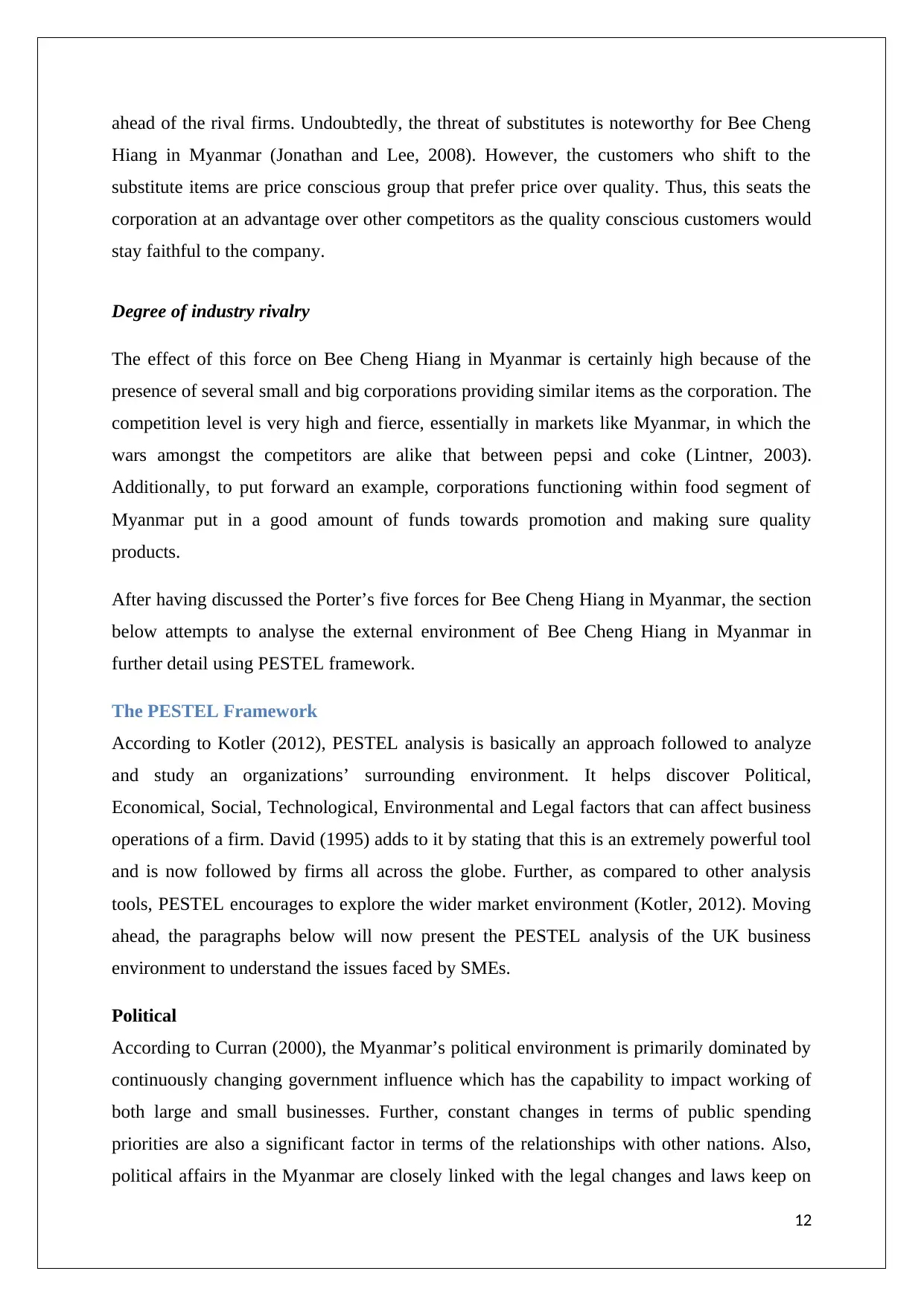
ahead of the rival firms. Undoubtedly, the threat of substitutes is noteworthy for Bee Cheng
Hiang in Myanmar (Jonathan and Lee, 2008). However, the customers who shift to the
substitute items are price conscious group that prefer price over quality. Thus, this seats the
corporation at an advantage over other competitors as the quality conscious customers would
stay faithful to the company.
Degree of industry rivalry
The effect of this force on Bee Cheng Hiang in Myanmar is certainly high because of the
presence of several small and big corporations providing similar items as the corporation. The
competition level is very high and fierce, essentially in markets like Myanmar, in which the
wars amongst the competitors are alike that between pepsi and coke (Lintner, 2003).
Additionally, to put forward an example, corporations functioning within food segment of
Myanmar put in a good amount of funds towards promotion and making sure quality
products.
After having discussed the Porter’s five forces for Bee Cheng Hiang in Myanmar, the section
below attempts to analyse the external environment of Bee Cheng Hiang in Myanmar in
further detail using PESTEL framework.
The PESTEL Framework
According to Kotler (2012), PESTEL analysis is basically an approach followed to analyze
and study an organizations’ surrounding environment. It helps discover Political,
Economical, Social, Technological, Environmental and Legal factors that can affect business
operations of a firm. David (1995) adds to it by stating that this is an extremely powerful tool
and is now followed by firms all across the globe. Further, as compared to other analysis
tools, PESTEL encourages to explore the wider market environment (Kotler, 2012). Moving
ahead, the paragraphs below will now present the PESTEL analysis of the UK business
environment to understand the issues faced by SMEs.
Political
According to Curran (2000), the Myanmar’s political environment is primarily dominated by
continuously changing government influence which has the capability to impact working of
both large and small businesses. Further, constant changes in terms of public spending
priorities are also a significant factor in terms of the relationships with other nations. Also,
political affairs in the Myanmar are closely linked with the legal changes and laws keep on
12
Hiang in Myanmar (Jonathan and Lee, 2008). However, the customers who shift to the
substitute items are price conscious group that prefer price over quality. Thus, this seats the
corporation at an advantage over other competitors as the quality conscious customers would
stay faithful to the company.
Degree of industry rivalry
The effect of this force on Bee Cheng Hiang in Myanmar is certainly high because of the
presence of several small and big corporations providing similar items as the corporation. The
competition level is very high and fierce, essentially in markets like Myanmar, in which the
wars amongst the competitors are alike that between pepsi and coke (Lintner, 2003).
Additionally, to put forward an example, corporations functioning within food segment of
Myanmar put in a good amount of funds towards promotion and making sure quality
products.
After having discussed the Porter’s five forces for Bee Cheng Hiang in Myanmar, the section
below attempts to analyse the external environment of Bee Cheng Hiang in Myanmar in
further detail using PESTEL framework.
The PESTEL Framework
According to Kotler (2012), PESTEL analysis is basically an approach followed to analyze
and study an organizations’ surrounding environment. It helps discover Political,
Economical, Social, Technological, Environmental and Legal factors that can affect business
operations of a firm. David (1995) adds to it by stating that this is an extremely powerful tool
and is now followed by firms all across the globe. Further, as compared to other analysis
tools, PESTEL encourages to explore the wider market environment (Kotler, 2012). Moving
ahead, the paragraphs below will now present the PESTEL analysis of the UK business
environment to understand the issues faced by SMEs.
Political
According to Curran (2000), the Myanmar’s political environment is primarily dominated by
continuously changing government influence which has the capability to impact working of
both large and small businesses. Further, constant changes in terms of public spending
priorities are also a significant factor in terms of the relationships with other nations. Also,
political affairs in the Myanmar are closely linked with the legal changes and laws keep on
12
⊘ This is a preview!⊘
Do you want full access?
Subscribe today to unlock all pages.

Trusted by 1+ million students worldwide
1 out of 28
Your All-in-One AI-Powered Toolkit for Academic Success.
+13062052269
info@desklib.com
Available 24*7 on WhatsApp / Email
![[object Object]](/_next/static/media/star-bottom.7253800d.svg)
Unlock your academic potential
Copyright © 2020–2025 A2Z Services. All Rights Reserved. Developed and managed by ZUCOL.